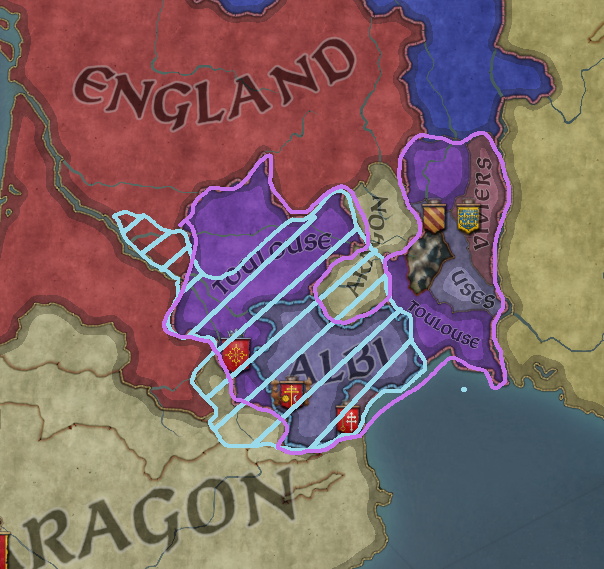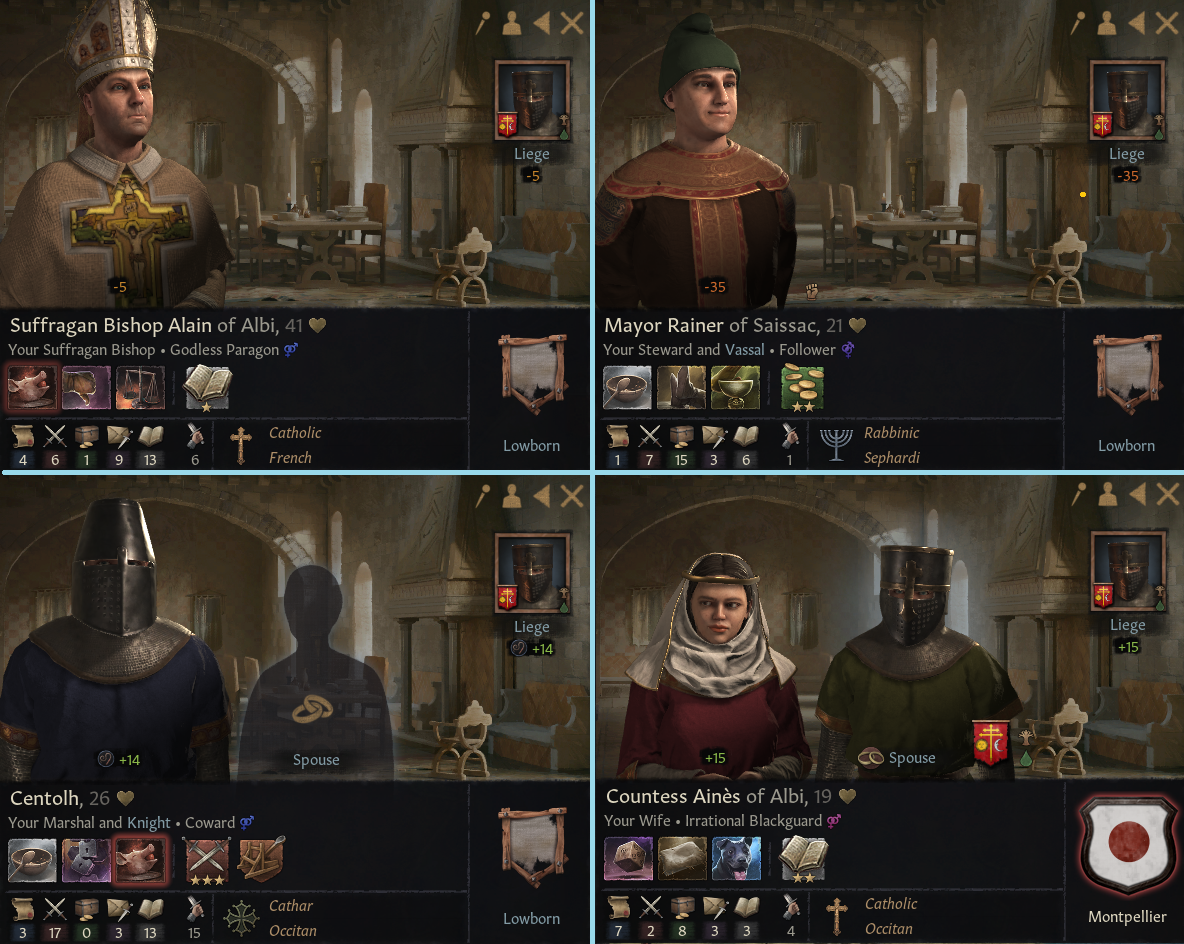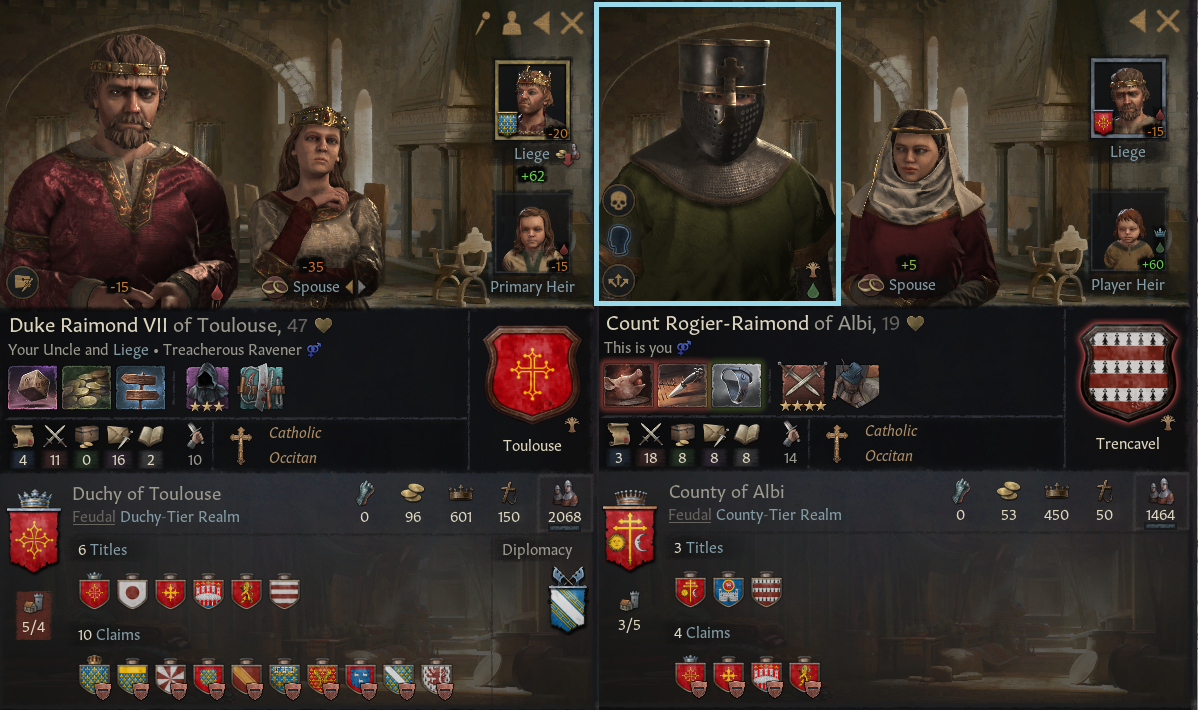Capítol Un - Occitania, Tèrra de Fòrça Reis
(Chapter One - Occitania, Land of Many Kings)
A 15th century painting of Viscount Rogier-Raimond riding into battle atop his trusty mount Bucèfal with his preferred weapon, the war-hammer.
The origins of house Trencavel are nebulous, but its first well-known member, Ato I, died in the early 10th cenury, ruling the viscounty of Albi, the ancestral seat of the house. It is from Albi that the nutcrackers would rule and expand their holdings, often against the will of the Counts (Dukes) of
Tolosa, and the Counts (Dukes) of Barcelona. As Albi and the Trencavel realm laid between both Toulouse and Barcelona, conflict was inevitable, and thus the members of House Trencavel learned early on how to play them against each other, often siding with the most powerful of the both when convenient.
We begin our story on the year 1204 AD, as
Viscomte Raimon Rogièr presides over the counties of Albi,
Besièrs , and
Carcassona. This unique position makes him both a subject of the Duke of Toulouse (Albi, Beziers), and the Duke of Barcelona (Carcassonne). Such a position is impossible to emulate in-game, and thus the Trencavels are subject to the Toulousians, rather than the Catalans. As the conflict with the English Kings continues to escalate, the Occitan nobility has divided their support among the Plantagenets, Capets, as well as the Catalans, with their lands becoming the battleground for these three kingdoms. The Duchy of Toulouse remains loyal to the French crown, as do the Trencavels, but the rise of Catharism in the region has brought about change, and sides are oft to be changed in times of trouble...
The Viscounty of Albi, within the County (Duchy) of Toulouse, in purple. Also pictured is the majority Cathar areas, circled in light blue, and encompassing the entirety of the Trencavel lands.
Being orphaned by his father at the tender age of eight, and by his mother a mere six years later, the Count Rogier-Raimond was raised and tutored by a trusted subject of his late father, Bertrand de Saissac, who held lands near Carcassonne. Bertrand was among the early converts to Catharism, and thus was somewhat of an unusual and controversial figure, often coming into conflict with the local Catholic clergy as he sought to spread Catharism. Bertrand's guidance provided an open-minded perspective to the young Count
, who in turn became sympathetic to the heretics and adopted a rather lax attitude to other cultures and religions, also nearly unknown throughout this time, as Catholic rulers became increasingly rigid and intolerant. While his second father Bertrand was a heretic, Count Rogier remained a Catholic, but surrounded himself with a diverse group of councilors and learned man, adopting a quite laissez-faire attitude about foreign cultures and religions, becoming known for his reliance on Jews to administer his second seat of power, Beziers, as well as historically leading and dying for the Cathars.
Some of the most prominent figures in Count Rogier's council, including a godless French Bishop, a skillful Jewish bureaucrat, his local Ocittan wife, and his closest supporter, the robust Centolh, a knight of the Cathar faith.
While the religious tolerance of Count Rogier was quite unusual for a 13th century monarch in Europe, it was not unique. Many fellow vassals, as well as his overlord Duke Raimond VII, were tolerant of the Cathar cause, with plenty adopting the heresy in secrecy. For many it was not out of kindness however, but merely pragmatism, with Duke Raimond VII leading amongst them. It was far easier to collect taxes if he tolerated and supported the heretics who were now the majority in his lands, as adherence to the rules of Rome could see his income plummet. This was somewhat of a pattern for the house of Toulouse, who often squabbled with the Trencavel over the riches in their lands, especially Carcassonne. Count Rogier's late aunt Beatrice had been married to the Duke's late father, Raimond VI, and thus the Toulouse and Trencavel families were linked by blood, but an enmity remained between the two, and both awaited for signs of weakness in order to pounce on their rivals. Of course, the age difference favored the young Count, who eagerly awaited for the impromptu death of his overlord in order to seize the Duchy of Toulouse, which he claimed as birthright.
Count Rogier-Raimond and his overlord, Duke Raimond VII
Whilst the internal politics of Toulouse could explode at any time, the real players in the region were King John of England, King Philippe of France, and King Pere of Aragon, all vying for power in Southern France using the local lords against each other, setting Aquitaine ablaze as their armies marched toward mutual destruction. In many ways, all three of these monarchs would have profound effects on their respective kingdoms which would be felt for centuries to come.
The Capetian King would historically triumph over his rivals, conquering most of the continental possessions of the English crown, as well as solidifying power in Southern France by supporting the Albigensian Crusades and defeating their Aragonese and Catalan allies. At this point in our story however it had only been five years since his grueling war against the English King Richard "Cœur de Lion," or Lionheart, which saw Philippe II nearly drown and lose all his territories, only stopped by the inopportune death of Richard during a siege involving one of his vassals. King Philippe would be the first "King of France," as his predecessors had used the term "King of the Franks" instead, beginning the centuries long genesis of a distinct French nation.
The reign of Richard's successor would see the continuation of his foreign policy toward the French, seeing King John embroiled in a conflict with the Capetian King for nearly the entirety of reign, culminating in his defeat and loss of much of their continental possessions, putting an end to the Angevin Empire. It was this defeat that eventually led to a barons' rebellion, nearly deposing John, and forcing him to sign the famous Magna Carta, as well as putting an end to French as the official tongue of the English court, turning England inwards, adopting a more "English" identity as opposed to previous rulers like Richard who seldom even visited the island.
Unlike his two rivals, Pere II "the Catholic" of Aragon enjoyed relative peace within his realm, becoming an active participant in the Reconquista, helping turn the tide against the Muslim realms of Iberia, whilst exerting great influence in Occitania, which to this day remains far more similar to Catalonia and the surrounding regions than to their French neighbors to the North. Having marriage ties to the Duke of Toulouse, and enjoying nominal lordship over him, Pere II would come to the aid of the Cathars during the Albigensian Crusades, regardless of the irony this presented when juxtaposed to his moniker "the Catholic" (which he earned by being the first King of Aragon to ever be crowned by the Pope). His defeat in the Albigensian Crusade would put an end to Occitan civilization as previously known, being forced to abandon its links with their neighbors in Iberia as they lost their autonomy and were subjugated under the Parisian Yoke.
The Three Kings of Occitania
This is the state of the former Kingdom of Aquitaine, the lands of Occitania, and the stronghold of the Cathars. Count Rogier-Raimond must transverse through the turmoil of 13th century Occitan politics if house Trencaval has any hopes of ever becoming more than mere counts in a region already saturated with counts. Will he prevail against history and restore Aquitaine to greatness, or will he end on a Crusader spear as he did on the original timeline? Only time will tell. Meanwhile, the nutcrackers must dance.
---------------------------------
For a bit of flavor and authenticity I will be using certain terms and names in their native Occitan (or if unavailable, in Catalan), at least for their introduction although some will be dropped to be congruent with the mechanics of CK3. In real life neither Toulouse nor Barcelona were duchies for example, but counties, and what we know as counties in CK3 were actually viscounties. It would be confusing however to refer to the Duke of Toulouse as a count when every in-game picture refers to him as Duke, and thus if you notice any
italics in the text, it will usually refer to their actual title and/or names in the native tongue.













